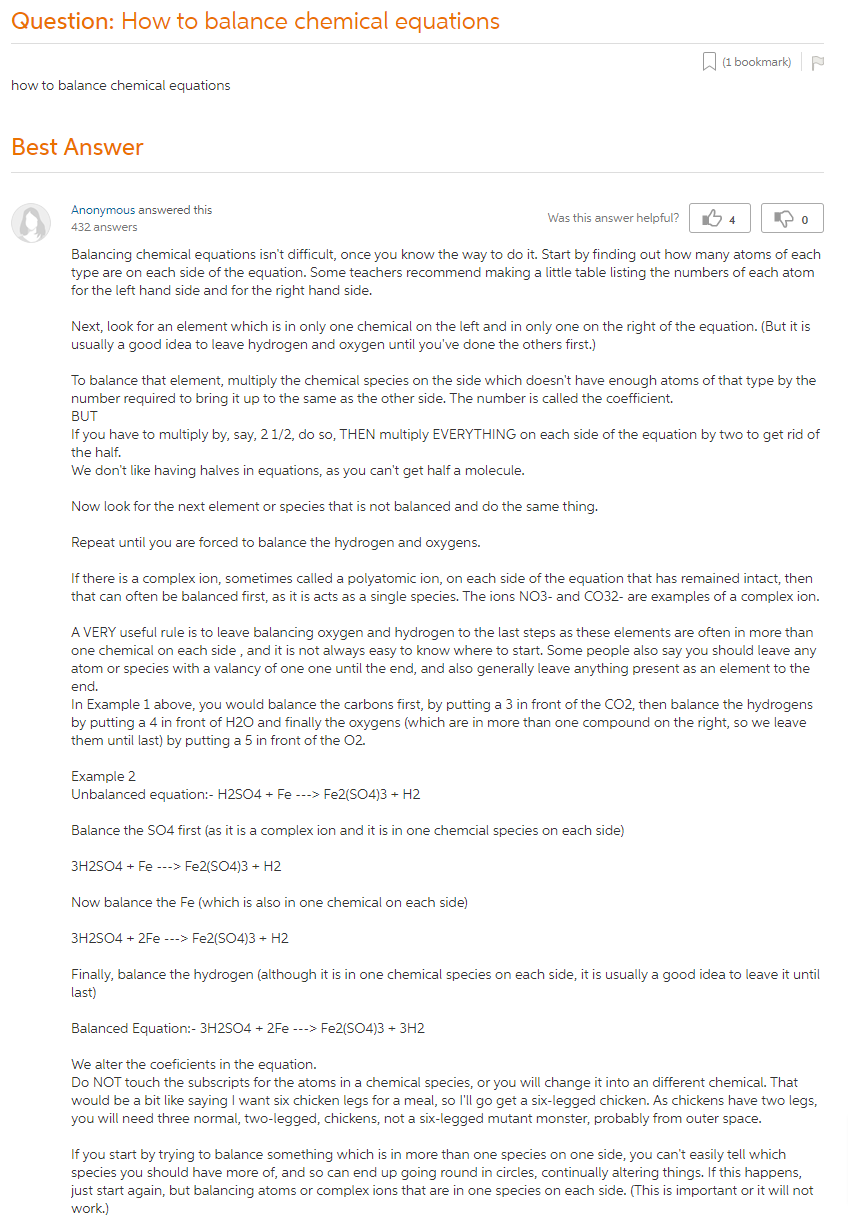
Transcribed Text:
Question: How to balance chemical equations
(1 bookmark)
how to balance chemical equations
Best Answer
Anonymous answered this 432 answers
Was this answer helpful? Ba
po
Balancing chemical equations isn’t difficult, once you know the way to do it. Start by finding out how many atoms of each type are on each side of the equation. Some teachers recommend making a little table listing the numbers of each atom for the left hand side and for the right hand side.
Next, look for an element which is in only one chemical on the left and in only one on the right of the equation. (But it is usually a good idea to leave hydrogen and oxygen until you’ve done the others first.)
To balance that element, multiply the chemical species on the side which doesn’t have enough atoms of that type by the number required to bring it up to the same as the other side. The number is called the coefficient. BUT If you have to multiply by, say, 21/2, do so, THEN multiply EVERYTHING on each side of the equation by two to get rid of the half. We don’t like having halves in equations, as you can’t get half a molecule.
Now look for the next element or species that is not balanced and do the same thing.
Repeat until you are forced to balance the hydrogen and oxygens.
If there is a complex ion, sometimes called a polyatomic ion, on each side of the equation that has remained intact, then that can often be balanced first, as it is acts as a single species. The ions NO3- and CO32- are examples of a complex ion.
A VERY useful rule is to leave balancing oxygen and hydrogen to the last steps as these elements are often in more than one chemical on each side, and it is not always easy to know where to start. Some people also say you should leave any atom or species with a valancy of one one until the end, and also generally leave anything present as an element to the end. In Example 1 above, you would balance the carbons first, by putting a 3 in front of the CO2, then balance the hydrogens by putting a 4 in front of H20 and finally the oxygens (which are in more than one compound on the right, so we leave them until last) by putting a 5 in front of the O2.
Example 2 Unbalanced equation:- H2SO4 + Fe —> Fe2(SO4)3 + H2
Balance the S04 first (as it is a complex ion and it is in one chemcial species on each side)
3H2SO4 + Fe —> Fe2(SO4)3 + H2
Now balance the Fe (which is also in one chemical on each side)
3H2SO4 + 2Fe —> Fe2(SO4)3 + H2
Finally, balance the hydrogen (although it is in one chemical species on each side, it is usually a good idea to leave it until last)
Balanced Equation:- 3H2SO4 + 2Fe —> Fe2(SO4)3 + 3H2
We alter the coeficients in the equation. Do NOT touch the subscripts for the atoms in a chemical species, or you will change it into an different chemical. That would be a bit like saying I want six chicken legs for a meal, so I’ll go get a six-legged chicken. As chickens have two legs, you will need three normal, two-legged, chickens, not a six-legged mutant monster, probably from outer space.
If you start by trying to balance something which is in more than one species on one side, you can’t easily tell which species you should have more of, and so can end up going round in circles, continually altering things. If this happens, just start again, but balancing atoms or complex ions that are in one species on each side. (This is important or it will not work.)